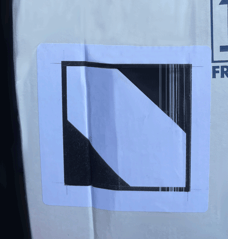Dangerous Goods Labels and Marks: The Risks of “Do It Yourself” Printing

Preparing and transporting packages containing dangerous goods are activities where care and enforcement of regulations are a basic requirement both in terms of safety (one's own and others') and to avoid having goods blocked, rejected, or having to pay penalties in some cases even high. In order to identify the dangerous goods you are going to ship, it is necessary that they be properly marked. Therefore, the choice of the type of dangerous goods labels and marks cannot be left to chance and should never be the result of a do-it-yourself printing or an impromptu purchase.
Often non-compliant products are found on the market, or one relies-often in good faith-on manufacturers who do not know the characteristics of the supports required by the regulations and who supply an item lacking the physical (type of printing substrate) and graphic (type and size of characters, thickness of lines and distances between elements) characteristics required by the regulations. The most common mistake is one in which, after learning of the marking and labelling requirement, one decides to independently print on plain paper-perhaps on a home inkjet printer-the label or mark one needs.
What the regulations say
Labels and dangerous goods labels must meet specific requirements for quality, size, and graphics. The ADR, for example, in section 5.2.2.2 lists very stringent specifications: labels must be compliant in colour, symbols, shape and size to the models given in the regulation. The proportions among graphic elements, line spacing and thickness, and font size must follow a set of guidelines that leave no room for interpretation. All elements must then be clearly legible and indelible. Labels must be able to be exposed to the weatherwithout appreciable degradation.
And it is precisely by reading the regulations that it becomes clear how impossible it is for a “Do It Yourself” label to ever be considered compliant.
Furthermore, if the labels are intended for maritime transport according to the IMDG Code, as defined in Chapter 5.2.2.2.1.7, the labels and marks identifying dangerous goods must still be legible after a 90-day exposure in seawater.
Finally, the IATA manual regulating the movement of dangerous goods by air specifies in Chapter 7.2.2.1 that labels must be resistant to exposure to weathering without losing their effectiveness and also defines the parameters of the colours to be used.
The risks one faces
It follows that it is critical not only to identify the goods in the correct manner, but that the labels and danger marks purchased are compliant and meet the required specifications of the carrier you are going to use. It seems obvious that a label printed on plain paper cannot withstand the bad weather or be legible after three months of immersion in seawater, yet it may happen to see them applied or find them on the market.
Here is an example (pictured) where several errors are clearly evident.
 The mark is badly printed
The mark is badly printed
A mark printed with an inkjet, perhaps running out of cartridges, and generating the classic faded lines in fields that should be full, certainly does not meet the specifications required by the regulations and is certainly not compliant. Such printing does not make the brand clearly identifiable and certainly cannot withstand the elements. An ordinary printer cannot and does not have the necessary features to generate a label or mark that complies with the regulations.
- The size
The regulations for shipping dangerous goods are clear: if the packaging is large enough to hold the mark in the standard size (100x100mm), you cannot use the mark in the reduced version. In this picture, the size of the mark is absolutely random.
- Application is as important as product quality
It is obvious that the position of the mark illustrated in the picture is not correct. The mark and dangerous goods labels should be applied "diamond-shaped." Therefore, in this case the mark should have been placed rotated 45° (with the black fields at the top and bottom) not as in the picture. Only IATA regulations allow this system of application, but this is definitely not the case we are analysing.
Buying and using such products is risky in several respects. First, one can incur penalties. To give an example, the Highway Code (Art. 168 c. 9) in the case of missing, worn-out or non-compliant ADR markings for the transport of dangerous goods applies a fine (for the principal, driver and owner of the vehicle) ranging from a minimum of 414 to a maximum of 1,665 euros, with suspension of license and registration card for a period of two to six months.
Even more serious for those involved in handling dangerous goods is the stop of the goods with the requirement to relabel them, which entails a new expense of purchasing compliant products in addition to the cost of processing by companies experienced in this area.
How to be you don't make mistakes
When it comes to safety, “Do It Yourself” printing is not an option.
Making sure, therefore, that you are using the correct dangerous goods labels and marks is essential to shipping without risk. Having a reliable supplier is the crucial first step in making sure your dangerous goods arrive at their destination.
At Serpac, we specialize in this. We manufacture and supply labels that comply with all regulations, and we can also make custom labels. The materials we use to produce our dangerous goods labels and marks are durable and meet all graphic and physical characteristics required by regulations. With our products, your goods always arrive at their destination.
Contact us, we are available to provide all the support you need.
Ship safe, think Serpac!